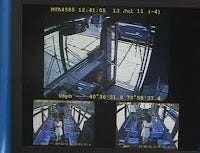Surveillance cameras which record audio are being put on buses & trains.

Washington - Around Washington, surveillance cameras are always watching. They peer from rooftops, lurk at intersections and even observe people riding a bus to work.
And on Montgomery County’s Ride On buses, the cameras do more than capture what they see. Many cameras also record what they hear, a little-known function that bothers civil liberties advocates. They see a creeping erosion of privacy in the growing use of audio recording technology on public transit.
The Maryland Transit Administration began audio recording in October on some buses in and around Baltimore and hopes to expand that to about half of the agency’s 700 buses by summer.
In San Francisco, buses and trains have both audio and video recording, with the audio devices always running. And in Atlanta, transit officials are adding video and audio recording to buses and will put them on trains next.
The stated intention of the systems on the nearly 300 Ride On buses with audio recording is to capture what drivers say. But the systems, which are always recording, are capable of picking up conversations of people sitting or standing near the drivers. A passenger talking to a spouse or child could end up being recorded, the snippet saved for several days on the system’s hard drive.
Some privacy experts say audio recording devices such as those on Ride On raise serious concerns. Millions of commuters in the region board buses each year for the thousands of daily runs on the hundreds of routes snaking through the area.
From body scans and pat-downs at airports to bag searches at subway stations, most Americans have come to accept less privacy while traveling since the Sept. 11 terrorist attacks ushered in a new era of transportation security.
On Ride On, the cameras are there for the safety of both drivers and riders, said Esther Bowring, a spokeswoman for Montgomery County. The recordings are accessed only in the event of an accident or other incident, such as an attack on a driver or a complaint of driver misconduct.
“If you’re not doing anything, you have nothing to worry about,” Dantanio Stroman, 23, said while waiting for a Ride On bus in Silver Spring.
Ride On’s audio devices, which are near the driver, are recording at all times because a driver might not have time to activate it, Bowring said. “If people are having normal conversations or talking on their phones, they’re not going to be able to record that,” she said. But a the recording devices could pick up a person who is shouting or speaking loudly on the bus, Bowring said.
David Rocah, a staff attorney with the American Civil Liberties Union of Maryland, said that just because a conversation is taking place on a bus doesn’t mean “there’s no reasonable expectation of privacy.”
A lone bus rider who thinks only the driver can hear them might say something personal. And if no one else is around, that rider should be able to expect privacy, Rocah said.
The law treats audio and video recording differently, and people act accordingly, Rocah said. The different treatment stems from a common belief that there can be “more at stake in terms of what we say than what we do in public,” he said.
As a result, people often have “very private conversations” in public if they think no one can hear them, he said.
Stickers are posted on Ride On buses to alert riders about the recording devices on board. But having such a sticker or sign doesn’t mean a rider automatically forfeits privacy, in part because many riders have no choice but to use public transit, Rocah said.
http://www.washingtonpost.com/local/trafficandcommuting/on-buses-cameras-are-watching-and-listening/2012/12/02/65f234f2-1a28-11e2-aa6f-3b636fecb829_story.html
TSA/DHS Intercity bus security grant program (IBSGP)
The TSA/DHS is responsible for the proliferation of surveillance cameras in our buses & trains.
In fiscal year (FY) 2011, the total amount of funds distributed under this grant program was $4,990,000. FY 2011 IBSGP funds were awarded to support the creation of a sustainable program for the protection of intercity bus systems and the traveling public from terrorism.
The FY 2011 IBSGP used a risk-based prioritization consistent with DHS policy. The Federal
Emergency Management Agency (FEMA), in conjunction with the Transportation Security
Administration (TSA), verified compliance with each of the administrative and eligibility criteria identified in the guidance. Eligible applications were reviewed and scored by a Federal
interagency working group, including representatives from TSA, Federal Motor Carrier Safety
Administration (FMCSA), and FEMA. FEMA and TSA then reviewed the interagency
recommendations and made recommendations for funding to the Secretary of DHS.
"Public awareness campaigns for enhanced over-the-road bus security (must be DHS approved").
"Modifying over-the-road buses to increase their security."
"Installing cameras and video surveillance equipment on over-the-road buses and at
terminals, garages, and over-the-road bus facilities."
"Establishing and improving an emergency communications system linking drivers and
over-the-road buses to the recipient’s operations center or linking the operations center
to law enforcement and emergency personnel."
http://www.fema.gov/sites/default/files/orig/fema_pdfs/pdf/government/grant/2011/fy11_ibsgp_factsheet.pdf


